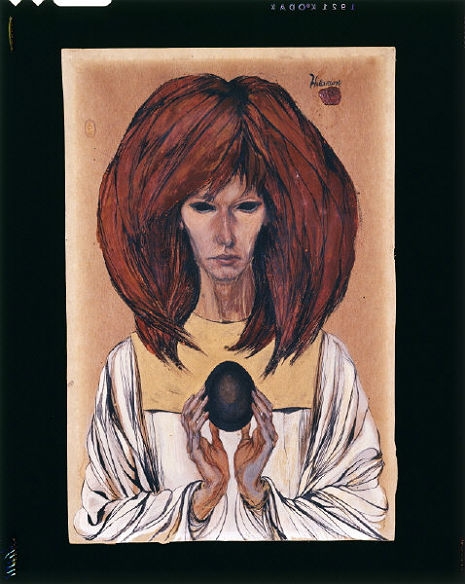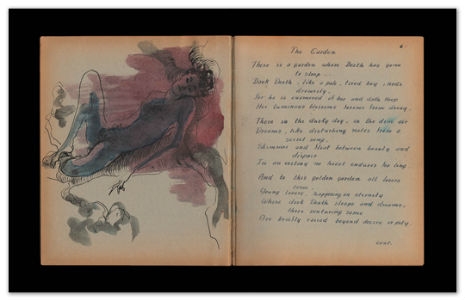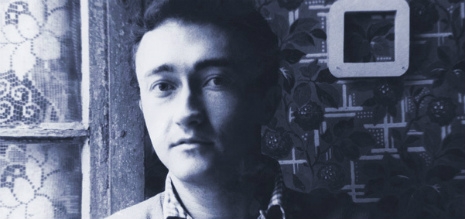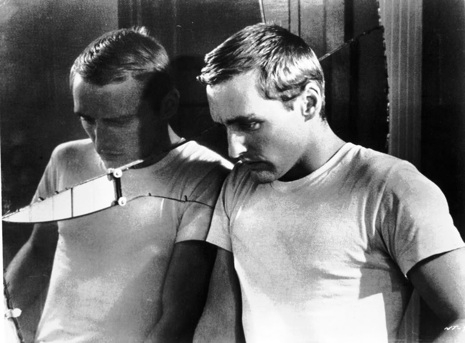
Okay, where do I begin?
First my respects to the amazing and kooky Miss Debbie Reynolds, a great and truly iconic Hollywood star.
Although most obituaries chose to skip over this (in every sense of the word) incredible moment in Reynolds’ career, What’s the Matter with Helen? is definitely worth a look. The film was directed by the bizarre Curtis Harrington, who began and ended his career by making the same short film version of Edgar Allen Poe’s The Fall of the House of Usher. The first when he was just sixteen years old in 1942, and the second at age 73 in 2000. Like Kenneth Anger, Harrington started making short experimental films in his teens in the 1940s. He befriended Anger and was featured in his 1954 film Inauguration of the Pleasure Dome playing Cesare, the Somnambulist. Harrington would later shoot Anger’s Puce Moment.
The young Curtis Harrington was a charter member of the Hollywood underground which revolved around people like Anger, witchy artist Marjorie Cameron (the subject of Harrington’s short film “The Wormwood Star”), silent movie actor Samson De Brier and other druggy, gender-bending, rule-breaking free thinkers. Satanists, homosexuals, witches, freaks, drag queens, artists, murderers, millionaires and bums, the whole gamut of Hollywood Babylon as we know it today long before things of the sort became popular in the sixties. In the 1950s this was as far underground as Hell itself. The most amazing part of this is, of course, that so many of the biggest stars of the day were enamoured with these people, had to have them at their parties and had different levels of social (and sexual) involvement that will provide facts, info and weird stories to obsess on for decades to come. Unlike Kenneth Anger, Curtis Harrington headed for the hills (Hollywood, that is), and had a decent career making mostly odd horror films (and TV shows like Dynasty) while continuing to do his short experimental art films. What’s The Matter With Helen? is one of the best of his feature films.
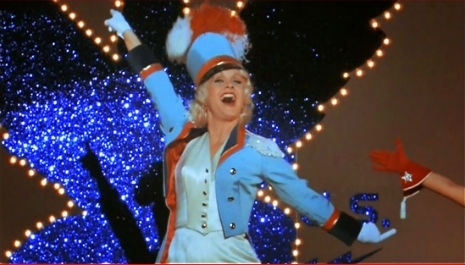
By 1971 there was a already an established trend in Hollywood horror films, dubbed the “Grande Dame Guignol Cinema,” it’s something that has also been called the “hagsploitation” or “psycho-biddy” genre. I refer to films like What Ever Happened to Baby Jane?, Hush… Hush, Sweet Charlotte and What Ever Happened to Aunt Alice?. Although Billy Wilder’s Sunset Boulevard could technically be said to be the first, the advent of the hag genre exploded of course with Whatever Happened to Baby Jane? starring the aging Bette Davis and Joan Crawford letting their hair (and their faces) down. Way down. Which was the entire professional requirement other than being a former leading lady. Since Curtis Harrington knew so many big stars from the 1930s and 40s who were growing into their fifties and wondering what to do with their careers, he made a few hagsploitation movies himself.

Another thing Curtis Harrington had in his pocket by 1971 was his choice of the cream of the crop of old Hollywood’s wildest, weirdest and campiest actors, as well as some of new Hollywood’s most annoying child freaks, especially since the plot of What’s The Matter With Helen? included Reynolds playing a children’s tap dance teacher in 1930’s Hollywood. So many cheese-eating hamster hambones in this one.
_465_263_int.jpg)
To quote Shelley Winters:
It’s about two women during the thirties who run a school to turn out Shirley Temples, and in my next scene I have to stab Debbie Reynolds to death. Poor Debbie — they’d better not give me a real knife.”
Harrington’s cream of the crop, being the eccentric that he was, was just incredible. A who’s who of a pop culture obsessive’s dreams. On the top end of What’s The Matter With Helen?‘s credits we have, of course, Reynolds, Winters and future McCloud actor Dennis Weaver joined by the very old time super actor Michael Mac Liammóir (whose name had at least three different spellings), described in a IMDB bio as:
... a theatrical giant who dominated Irish theatre for over 50 years. Actor, designer, playwright and brilliant raconteur he was very much his own creation. He cut an imposing figure under the spotlight and in real life dressed flamboyantly wearing full make-up at all times and a jet black hairpiece. When he died in 1978 aged 79 The Irish Times wrote that ‘Nobody can assess the contribution that Micheal MacLiammoir made to Irish theatre’....Sir John Gielgud commented “Designer, wit, linguist and boon companion as well as actor, he was a uniquely talented and delightful creature.”

As What’s The Matter With Helen?‘s credits roll they further reveal a string of incredible characters: Agnes Moorehead (who had an unforgettable Hollywood career but is mostly remembered as Endora on Bewitched), wild fifties (very) bad girl Yvette Vickers (Attack of the Giant Leeches, Reform School Girl, Juvenile Jungle, Attack of the 50 Foot Woman, and more), and Timothy Carey (possibly the single most out there Hollywood actor in the history of film, who saved his money from movies like The Wild One, East of Eden, The Killing, Naked Gun, Rumble on the Docks, Poor White Trash/Bayou, Beach Blanket Bingo, Head and so many more, to make his masterpiece, The World’s Greatest Sinner with soundtrack by a young Frank Zappa. [Carey spent his later years going on TV talk shows and shooting a movie with his son Romeo called The Devil’s Gas about the importance of farting. Yes that’s what I said]. But beyond them, it also features Pamelyn Ferdin, the most annoying fingernails-on-the- blackboard child actress of the sixties and seventies (who turns up in odd films like The Christine Jorgensen Story and was seemingly on every TV show ever made back then such as My Three Sons, The Monkees, The Paul Lynde Show, Sigmund and the Sea Monsters and too many more to mention.)
What’s The Matter With Helen? was written by Henry Farrell who wrote both What Ever Happened to Baby Jane? and Hush…Hush, Sweet Charlotte (most of these Hollywood hag films had titles that were full sentences or questions) the plot concerns a Leopold and Loeb-type thrill murder committed by the sons of two women who are drawn together by these horrible events. Destroyed by the trial, the shame and being attacked mentally and physically, they decide to run away to Hollywood, where they can change their names, reinvent themselves and start all over. There are quite a few amazing twists and turns in the story, gory murders (even a few bunny murders, the shame!), plus beautiful and weird cinematography that make it worth seeing more than once.
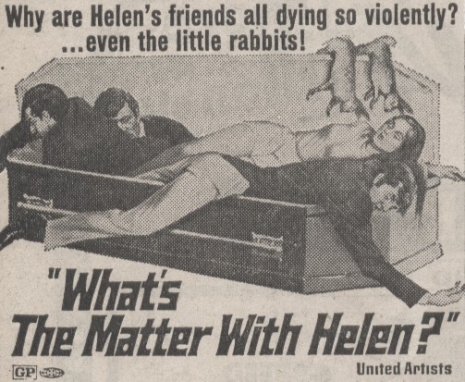
The insanity of some of the goings on behind the camera are legendary and hilarious. At first they couldn’t find a big name star to take the lead, but Debbie Reynolds eventually took the role of Adele. To quote her biography Unsinkable:
Eventually, Debbie Reynolds took the role of Adelle. She had a contract with NBC to be an uncredited producer of a film, so she chose this, taking no salary. “They put up $750,000 and hired Marty Ransohoff to be on the set, but I actually produced it.”
Incredibly—or not so incredibly considering who we’re talking about—Shelley Winters was in the middle of a nervous breakdown:
According to Reynolds, Winters’ psychiatrist advised her not to portray “a woman having a nervous breakdown because she was having a nervous breakdown! But nobody knew that, and so all through the film she drove all of us insane! She became the person in the film.” Reynolds witnessed Winters’s questionable mental status off of the set. The two had been friends many years before, and Reynolds offered to chauffeur Winters to and from the set. “I was driving one morning on Santa Monica Boulevard and ahead of me was a woman, wearing only a nightgown, trying to flag down a ride,” recalled Reynolds. It was Winters, who claimed, “I thought I was late.” According to a Los Angeles Times article published while the film was in production, Winters was so difficult on the set that the studio threatened to replace her with Geraldine Page.
More after the jump…









